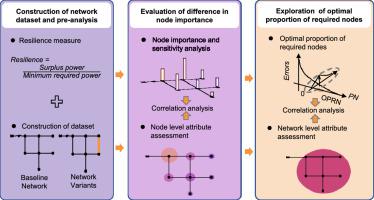Water Research ( IF 12.8 ) Pub Date : 2023-05-30 , DOI: 10.1016/j.watres.2023.120148 Xipeng Yu 1 , Yipeng Wu 1 , Xiao Zhou 2 , Shuming Liu 1

|
Accurate resilience evaluation for water distribution systems generally requires all nodes’ hydraulic data which are usually obtained from a well-calibrated hydraulic model. However, in reality, few utilities maintain a workable hydraulic model, making the resilience evaluation far more from practicability. Under this condition, whether resilience evaluation can be realized based on a small amount of monitoring nodes is still a research gap. Therefore, this paper investigates the possibility of accurate resilience evaluation using partial nodes by answering two problems: (1) whether the importance of nodes differs in resilience evaluation; (2) what proportion of nodes are indispensable in resilience evaluation. Accordingly, the Gini index of nodes’ importance and the error distribution of partial node resilience evaluation are computed and analyzed. A database including 192 networks is used. Results show that the importance of nodes in the resilience evaluation varies. The Gini index of nodes’ importance is 0.604 ± 0.106. The proportion of nodes that meet the accuracy requirement of resilience evaluation is 6.5% ± 2%. Further analysis shows that the importance of nodes is determined by the transmission efficiency between water sources and consumption nodes, and the degree of a node's influence on other nodes. The optimal proportion of required nodes is controlled by a network's centralization, centrality, and efficiency. These results show that accurate resilience evaluation using partial nodes’ hydraulic data is feasible and provide some basis for the resilience evaluation-orientated selection of monitoring nodes.
中文翻译:

基于部分节点水力信息的输水系统弹性评估
供水系统的准确弹性评估通常需要所有节点的水力数据,这些数据通常是从经过良好校准的水力模型获得的。然而,实际上,很少有公用事业公司维护可行的水力模型,使得弹性评估远离实用性。在此条件下,能否基于少量监控节点实现弹性评估仍是一个研究空白。因此,本文通过回答两个问题来探讨使用部分节点进行精确弹性评估的可能性:(1)节点重要性在弹性评估中是否存在差异;(2)弹性评估中不可缺少的节点比例是多少。因此,计算并分析了节点重要性的基尼指数和部分节点弹性评估的误差分布。使用包含 192 个网络的数据库。结果表明,节点在弹性评估中的重要性存在差异。节点重要性的基尼指数为0.604±0.106。满足弹性评估精度要求的节点比例为6.5%±2%。进一步分析表明,节点重要性由水源与消耗节点之间的传输效率以及节点对其他节点的影响程度决定。所需节点的最佳比例由网络的中心化、中心性和效率控制。

























 京公网安备 11010802027423号
京公网安备 11010802027423号